Historical Places in Bali to visit are a cultural treasure that enriches the experience of tourists who come to the island. Bali, famous for its natural beauty, also possesses a rich and fascinating cultural heritage. Through this article, we will take you on an extraordinary journey to explore 10 Historical Places in Bali that reflect the richness of the island’s cultural heritage. From majestic temples to historically significant sites shrouded in mystery, Bali is filled with stories waiting to be told to the world. Let’s begin this journey and discover the wonders of Historical Places in Bali.
Pura Besakih
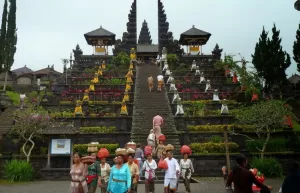
The first Historical Places in Bali is Besakih. Besakih is one of Bali’s most important historical sites, also known as “Pura Agung Besakih” or “Pura Besakih Mother Temple.” This complex of Hindu temples is located on the slopes of Mount Agung, Bali’s highest mountain. Pura Besakih was founded in the 8th century CE by King Anak Wungsu of the Ugrasena dynasty. It is the center of Hindu faith and devotion in Bali.
Pura Besakih has over 80 temples scattered throughout its complex, each with a different function and meaning. Each year, Pura Besakih celebrates major festivals such as Hari Raya Galungan and Kuningan, attracting thousands of visitors and Hindu faithful from around the world. The location also offers spectacular views of Mount Agung, making it one of Bali’s most famous cultural tourist destinations. Pura Besakih is located in the village of Besakih, Rendang district, Karangasem regency, Bali.
Pura Agung Uluwatu

source:backpackerjakarta.com
The second Historical Place in Bali is Pura Agung Uluwatu. Pura Agung Uluwatu is located in the village of Pecatu, South Kuta district, Badung regency, Bali. Pura Uluwatu is one of Bali’s iconic temples, situated at the extreme southern tip of the island. It was founded in the 11th century by a Hindu priest named Dang Hyang Dwijendra. Pura Uluwatu is renowned for its stunning location on cliffs overlooking the Indian Ocean.
One of the attractive features of Pura Uluwatu is the Kecak dance performance held there every evening at sunset. Additionally, visitors can enjoy breathtaking sunset views over the ocean from this location. Pura Uluwatu is also known as one of Bali’s protective temples against evil spirits, adding a spiritual and historical dimension to the place. To this day, Pura Uluwatu remains one of Bali’s most significant places of worship and tourism.
Goa Gajah

The third Historical Places in Bali is Goa Gajah. Goa Gajah is a historical site located in the village of Bedulu, Blahbatuh district, Gianyar regency. The name Goa Gajah means “Elephant Cave,” and it is a fascinating historical site in Bali. The cave dates back to the 11th century and was originally a Hindu temple. The name “Goa Gajah” comes from the statue of an elephant-like creature that adorns the cave’s entrance.
In addition to its interesting architecture, Goa Gajah also includes statues, a sacred pool, and a refreshing stream in its surroundings. Although the name suggests a connection to elephants, the site actually has no direct link to elephants. Goa Gajah is an important testament to the history of Hinduism’s development in Bali. It is located in the village of Bedulu, Blahbatuh district, Gianyar regency, Bali.
Puri Agung Karangasem
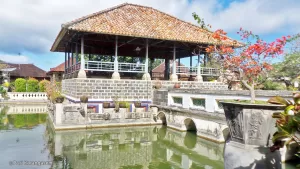
The fourth Historical Place in Bali is Puri Agung Karangasem. Puri Agung Karangasem is an impressive palace complex located in the center of Amlapura city, the capital of Karangasem regency, about 65 km from Denpasar, 12 km from the tourist area of Candidasa, 5 km from Taman Soekasada Ujung, and approximately 6 km from the tourist site of Tirtagangga. The palace has a rich history, having been built in the 19th century by Anak Agung Gede Jelantik, King Karangasem I. In addition to Puri Agung, there are also two other palaces within the royal complex closely related to Puri Agung, namely Puri Gede and Puri Kertasura.One of the main attractions of Puri Agung is its architecture, which combines elements of Balinese, Chinese, and European architecture, creating a unique and captivating appearance.Puri Agung consists of three main parts. The front part, called “bencingah,” is where traditional art performances are often held, while the right and left sides are used to receive visitors.
The central part, known as “jaba tengah,” is a garden area that houses two old lychee trees. The inner part of the complex serves as the main residence called “maskerdam,” which is named after the city of Amsterdam in the Netherlands, in homage to the friendly relationship between the Karangasem king and the Dutch government at the time. The Maskerdam was the king’s residence, while the other buildings at the rear were called “london” and were used as the royal family’s residence.In front of the Maskerdam palace is the “Bale Pemandesan,” used for tooth-filing ceremonies and as a temporary place for storing the remains of royal family members until cremation ceremonies (ngaben) take place.
Around the building, facing the pond, stands a large winged lion statue. In front of the Bale Pemandesan is the “Bale Pawedaan” or “Bale Lunjuk,” used for religious ceremonies. There is also the “Bale Kambang” or Gili in the middle of the pond, used for family gatherings and dance and art activities.Puri Agung Karangasem is a magnificent manifestation of Bali’s history and culture, a must-visit for anyone wanting to explore the beauty and richness of the island’s cultural heritage.
Taman Ayun Pura
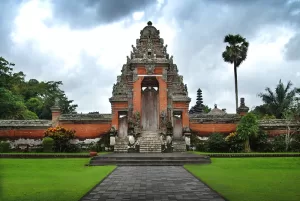
The fifth Historical Places in Bali is Taman Ayun Pura. Taman Ayun, located in the village of Mengwi, Mengwi district, Badung regency, Bali, approximately 18 kilometers west of Denpasar, is a true gem. Its name, which means “Temple in a Beautiful Garden,” fully reflects its exceptional beauty. Behind its aesthetics, Pura Taman Ayun has significant historical significance.
Pura Taman Ayun serves as the “Pura Ibu” (Paibon) for the Mengwi Kingdom. Built by King Mengwi, I Gusti Agung Putu, in 1634 CE (1556 Saka), this temple was originally located north of Mengwi village for the worship of his ancestors, known as Taman Genter. When Mengwi became an important kingdom, the king moved Taman Genter to the east and expanded the complex. The enlarged temple was officially consecrated as Pura Taman Ayun on the Tuesday of Kliwon-Medangsia in the fourth month of the year 1556 Saka. To this day, every Kliwon Tuesday in the Medangsia week of the Saka calendar, the temple celebrates its founding with a piodalan (ceremony).
Taman Ayun consists of three different types of gardens: taman pangarasan, taman umum, and taman suci. Each type of garden has a unique significance in Balinese culture. Taman Ayun is also renowned for its magnificent architecture and sacred ponds that symbolize harmony between man and nature.
Pura Tirta Empul

The sixth Historical Places in Bali is Pura Tirta Empul. Pura Tirta Empul is a renowned Hindu temple known for its sacred spring water that flows within it. Founded in 926 CE, this sacred site is still active today, attracting both pilgrims and tourists. One of its main attractions is the sacred water source where visitors bathe and pour sacred water over their bodies to purify themselves from sins and mistakes. Pura Tirta Empul is an important example of spiritual devotion and religious history in Bali. It is located in the village of Tampaksiring, Tampaksiring district, Gianyar regency, Bali.
Kingdom of Klungkung
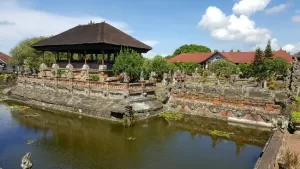
The seventh Historical Places in Bali is the Kingdom of Klungkung. The Kingdom of Klungkung is located on Puputan Klungkung Street, Semarapura, Klungkung regency, Bali. The Kingdom of Klungkung was founded in 1686, simultaneously with the construction of Puri Agung Klungkung in Semarapura. The formation of this kingdom occurred after I Dewa Agung Jambe, the son of Dalem Di Made, successfully suppressed the rebellion of I Gusti Agung Maruti. Although I Gusti Agung Maruti managed to take the Gelgel palace, which was then leveled, Gusti Agung Jambe, as the heir to the throne of the kingdom, was not interested in ruling there.
Instead, Gusti Agung Jambe chose to establish a new center of government in Semarapura, the former location of his hideout. Thus, the Kingdom of Klungkung was officially formed, and Semarapura became the new capital for the royal family of Klungkung.
Taman Soekasada Ujung

The eighth Historical Places in Bali is Taman Ujung Karangasem. Taman Ujung Karangasem, a magnificent work inspired by Anak Agung Agung Anglurah Ketut Karangasem, also known as Raja Karangasem I Gusti Bagus Jelantik, is one of the amazing tourist destinations in Karangasem. Originally, the park covered about 400 hectares of land, but today only about 10 hectares remain. Over time, most of these lands were redistributed to the community during the land reform period. Although the park is the private property of the Puri Karangasem family, it is open to the public for their enjoyment.
The construction of Taman Ujung began in 1909 through the initiative of Anak Agung Anglurah. The project involved a Dutch architect named van Den Hentz, a Chinese designer named Loto Ang, and a traditional Balinese undagi (architect). In reality, the park is an expansion of the Dirah pond built in 1901. The construction of Taman Ujung was completed in 1921. In 1937, the Taman Ujung Karangasem was officially inaugurated with a marble inscription containing text in Latin and Balinese scripts, as well as in two languages, Malay and Balinese.
Taman Ujung Sukasada has many facilities to enhance visitors’ comfort, including parking and restrooms. For those seeking accommodation near Taman Ujung Sukasada, it will not be difficult to find, as there are many lodging options offering various prices and amenities to suit individual needs and preferences. Taman Soekasada Ujung is located in the village of Tumbu, Karangasem district, Karangasem regency, Bali.
Candi Tebing Tegallinggah
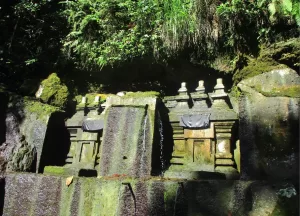
The ninth Historical Places in Bali is Candi Tebing Tegallinggah. Candi Tebing Tegallinggah is an archaeological site located in Bali, Indonesia, with little-documented history. The estimated age of the site and Candi Tebing Tegallinggah can be found in Bagus, A.A.G.’s research, which states that “temple structures along the Pakerisan River are considered to date from the Bali Kuna period, approximately from the 10th to the 14th century CE.” Their use was likely for religious ceremonial purposes, with reliefs of Hindu-Buddhist mythology. The site has been restored to preserve its historical and cultural heritage. As an attractive destination for tourists and history researchers, this temple reveals a part of Bali’s Hindu-Buddhist heritage. Candi Tebing Tegallinggah is located in the village of Bedulu, Blahbatuh district, Gianyar regency.
Taman Air Tirta Gangga
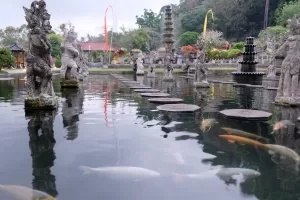
The tenth Historical Places in Bali is Tirta Gangga. Tirta Gangga, which means “Water of the Ganges” in Balinese, is a renowned water garden for its natural beauty and impressive irrigation system. The garden was initially created by King Karangasem, named Anak Agung Anglurah Ketut Karangasem, in 1946. Taman Air Tirta Gangga was built to symbolize Bali’s prosperity and natural beauty. King Karangasem, who was a lover of art and nature, wanted to create a place that would blend natural beauty with traditional Balinese architecture.
Tirta Gangga was designed as a resting place for the Karangasem royal family and became a sacred place for prayers. The garden is also considered a manifestation of Mount Agung, Bali’s highest mountain, which is regarded as a sacred mountain in Balinese culture. Therefore, Tirta Gangga holds great spiritual value for the Balinese community.
Taman Air Tirta Gangga was officially opened in 1948, two years after its construction began. This inauguration marked a historic moment for Karangasem and Bali as a whole. Since then, Tirta Gangga has become one of the primary attractions for tourists who want to experience the authenticity of Bali while connecting with a spiritually significant place.
Tirta Gangga is located in the village of Ababi, Abang district, Karangasem, in eastern Bali. Its proximity to Denpasar, approximately 83 kilometers away, makes it easily accessible for visitors looking to explore the natural and cultural beauty of eastern Bali. The garden is famous for its peaceful ambiance and stunning views, featuring fountains, iconic Balinese statues, a stone bridge, and lush gardens.
When visiting Tirta Gangga, you will experience the harmony between nature and Balinese culture. You can stroll through the garden, take photos amid beautiful flower beds, or even swim in the ponds filled with large koi fish. Additionally, you can have a spiritual moment by praying in one of the sacred areas within the garden.
There you have it, a presentation of the Historical Places in Bali. If you’re planning to travel to Bali, don’t forget to contact BaliEthnik!




